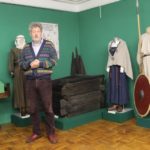A series of meetings has been launched in the Chernihiv Historical Museum named after Vasyl Tarnovsky “People of the old Hetman region”, dedicated to Ukrainian society of the XVII-XVIII centuries. It will be about people: what they were striving for, how lived, what did they believe. But we will not talk so much about hetmans and oligarchs, and more about "second plan" people, whose lives rarely come into the field of view of researchers. The main condition of our focus is the availability of attractions, related to these people in the funds of our museum.
The first such meeting took place 18 October 2022 Dr.. and was dedicated to a special family for the history of our museum - the noble-Cossack family of the Kochenovskys. The pedigree is traced through sources from the middle of the 15th century. and begins in the city of Kobrin on Beresteyshyn with the boyar Nekrash Semenovich Kochenovsky. A relative of Lev Nekrashevych - Hryhoriy Kochenovskyi was a metrician of the Grand Duchy of Lithuania and the owner of the first estate of Kochanivka in the Litynsky District of the Podilsk Voivodeship.
In the middle of the XVII century. we see representatives of the Kochenovskys among the Cossacks of the Belotserki regiment. In the last quarter of the 17th century. the Kochenovsky family is recorded in documents in Pryluky. Ivan Kochenovsky, a Cossack of the Prilut regiment, had three sons: Fedor, Kirill and Mykhailo. Two of them are Fedir Ivanovich and Kyrylo Ivanovich Kochenovski, thanks to natural talents and abilities, took a chance and got into the Imperial Singing Chapel in St. Petersburg. Mykhailo Ivanovich Kochenovsky had a military career, served as centurion Lokhvytskyi.
Colonel Fyodor Ivanovich Kochenovsky went down in history as the generous founder of Rykhliv Mykolaiv Monastery. In the collection of the Vasyl Tarnovsky Historical Museum of Chernihiv there is a unique exhibit - a silver gift box (chest). This majestic piece of jewelry was commissioned by Fyodor Ivanovich in Augsburg by one of the leading masters of the Rococo style, Bernhard Heinrich Weillet, and offered 1749 Dr.. to the Rykhlivskyi Sviato Mykolayivskyi Monastery, in which Fedir Kochenovsky also found his last refuge.
Do 1742 Dr.. Fyodor Kochenovsky bought a farm near the village of Parafiivka of the Ichnian hundred of the Prylutsky regiment, who was judged in the 19th century. to become a landmark center of Ukrainian culture. Purchase of properties near the village. Parish was not accidental: it was here that the "umbilical cord of the Kochenovsky family" was buried.
Living in St. Petersburg, Fedor Ivanovych Kochenovsky communicated closely with representatives of the peculiar Prylut community: Dubyansky, Bugaevsky, With frolics, Tarnovsky and Yuzefovych, Chizhevsky, Razumovskyi, Puchkovsky, Markevich, Throats. Their family and neighborhood ties are vividly reflected in the records of Major General Mykola Khanenko. It was in the midst of this circle of Ukrainian statesmen that the desire to implement the idea of restoring the hetmanship matured.
The Kochenovsky family was widespread in Chernihiv Oblast in the 19th century. Most of its representatives belonged to the spiritual state. A felon of the 18th century is kept in the museum's funds., which belonged to the Kochenovsky priests and was carefully restored with special piety in the middle of the 19th century. their descendants. Do 1871 Dr.. a descendant of the family priest of the Intercession Church in. By Simeon Kochenovsky of Berezny, a frame made of crimson velvet boards and a silver, engraved, gilded frame for the Gospel were made 1744 р., which was the contribution of Fyodor Ivanovich Kochenovsky to the Mykolaiv Parish Church.
Summarizing the extensive history of the Kochenovsky family, we can state, that Ukrainian society was at the same time traditionally conservative, but not preserved, therefore, there was a sufficient level of social mobility. Representatives of the Cossack community, who Kyrylo and Ivan Kochenovsky were in the middle of the 17th century., for conscientious and victorious service or execution of special assignments of the regimental foreman and hetmans, quickly advanced in career growth and received land ownership in a profitable and prestigious location. Later, their descendants were able to study at the Kyiv-Mohyla Academy, which opened up much wider life opportunities for them. Traditions of kinship by place of birth and education (such fellows and student fraternities of the 18th century.) were also an important factor for marriage, career and ownership strategies.
For a successful "social lift" alongside family members, friendly and client relationships played a big role. Supporting them, counted on the support of patrons, best men, countrymen, who rose to high ranks and had a successful career. Moreover, The Ukrainian elder was marked by a high level of religiosity, which manifested itself in generous charity and patronage for the benefit of churches and monasteries, especially those, which were related to family or patronage relationships.
Senior Research Fellow,
candidate of historical sciences Olga Heyda




More Stories
Commemoration of the liquidators of the consequences of the accident at the Chernobyl nuclear power plant
Needed, perhaps, God's gift to create beautiful things from clay
Exhibition “In memory of cultural workers...”